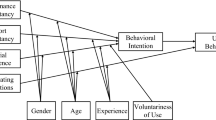Abstract
This study aims to examine the factors influencing the adoption of SMS among people with visual impaired and to investigate the SMS adoption as a main mechanism for sending messages among them. Cross-sectional data from 133 individuals with visual impaired who are using SMS were collected and used structural equation modeling (SEM) to examine the possible predictive relationships among the variables in the conceptual framework and hypotheses developed. Our findings demonstrate that usefulness is the main factor that influencing the adoption of SMS among people with visual impaired. Nonetheless, there is insufficient empirical evidence to support the relationship between ease of use, enjoyment, and perceived fees. This study also found that SMS is the main mechanism for sending messaging for visual impaired community. The benefits such as ease of use should not be neglected in the development of new functions and enhancement of service features especially for visual impaired community.
Access this chapter
Tax calculation will be finalised at checkout
Purchases are for personal use only
Similar content being viewed by others
References
Alex, I., & Dianne, C. (2014). Satisfaction with outcome and process from web-based meetings for idea generation and selection: The roles of instrumentality, enjoyment, and interface design. Telematics and Informatics, 31(4), 543–558.
Amenimiya, T., & Sugiyama, H. (2009). Haptic handheld wayfinder with pseudo-attraction force for pedestrians with visual impairments. Proceedings of the 11th International ACM SIGACCESS Conference on Computers and Accessibility, pp. 107–114.
Bagozzi, R.P., & Fornell, C. (1988). Theoretical concepts, measurement, and meaning. In C. Fornell (Ed.), A Second generation of multivariate analysis, New York, NY: Praeger.
Balandin, S., & Morgan, J. (1997). ‘Adults with cerebral palsy: What’s happening? Journal of al and Development Disability. 22(2), 109–124.
Browne, M. W., & Cudeck, R. (1993). Alternative ways of assessing model fit. In K. A. Bollen & S. Long (Eds.), Testing structural equation models. Newbury Park, CA: Sage.
Carolina, M., Tiago, O., & Aleš, P. (2014). Understanding the internet banking adoption: A unified theory of acceptance and use of technology and perceived risk application. International Journal of Information Management, 34(1), 1–13.
Chin, W. W. (1998). Issues and opinion on structural equation modeling. MIS Quarterly, 22(1), 7–16.
Chin, W. W., & Todd, P. A. (1995). On the use, usefulness, and ease of use of structural equation modeling in MIS research: A note of caution. MIS Quarterly, 19(2), 237–246.
Cronbach, L. (1951). Coefficient alpha and the internal structure of tests. Psychometrika, 16(3), 297–334.
Davis, F. (1989). Perceived usefulness, perceived ease of use and user acceptance of information technology. MIS Quarterly, 319–340.
Eric, W. K. (2012) User experience on mobile video appreciation: How to engross users and to enhance their enjoyment in watching mobile video clips. Technological Forecasting and Social Change, In Press, Corrected Proof, Available online April 18, 2012.
Garry, W., Keng-Boon, O., Lai-Ying, L., & Binshan, L. (2014). Predicting the drivers of behavioral intention to use mobile learning: A hybrid SEM-Neural Networks approach. Computers in Human Behavior, 36, 198–213.
Gerbing, D. A., & Anderson, J. C. (1992). Monte Carlo evaluations of goodness of fit indices for structural equation models. Sociological Methods & Research, 2(2), 132–160.
Guerreiro, T., Lagoá, P., Santana, P., Gonçalves, D., & Jorge, J. (2009). NavTap and brailletap: Non-visual texting interfaces. In Proceedings of Rehabilitation Engineering and Assistive Technology Society of North America Conference (Resna): Washington, D.C.
Hannu, V., Carolina, L. N., Francisco, J. M. C., & Harry, B. (2010). Analysis of users and non-users of smartphone applications. Telematics and Informatics, 2(3), 242–255.
Hoyle, R. H. (1995). The structural equation modeling approach: Basic concepts and fundamental issues. Thousand Oaks, CA: Sage.
Hu, L. T., & Bentler, P. M. (1999). Cutoff criteria for fit indexes in covariance structure analysis: Conventional versus new alternatives. Structural Equation Modeling, 6(1), 1–55.
Jaccard, J., & Wan, C. K. (1996). LISREL approaches to interaction effects in multiple regression. Thousand Oaks, CA: Sage.
Jongchul, O., & Sung-Joon, Y. (2014). Validation of haptic enabling technology acceptance model (HE-TAM): Integration of IDT and TAM. Telematics and Informatics, 31(4), 585–596.
Kim, Y. J., Eom, M. I. I., & Ahn, J. H. (2005). Measuring IS service quality in the context of the service quality-user satisfaction relationship. Journal of Information Technology Theory and Application, 7(2), 53–70.
Lai-Ying, L., Teck-Soon, H., Garry, W. T., & Keng-Boon, O. (2013). Predicting the determinants of the NFC-enabled mobile credit card acceptance: A neural networks approach. Expert Systems with Applications, 40(14), 5604–5620.
Lu, Y., Deng, Z., & Wang, B. (2010). Exploring factors affecting Chinese consumers’ usage of short message service for personal communication. Info Systems Journal, 20, 183–208.
Namkee, P., Mohja, R., Jinghui, H., & Kwan, M. L. (2014). Understanding the acceptance of teleconferencing systems among employees: An extension of the technology acceptance model. Computers in Human Behavior, 39(10), 118–127.
Shu, S. L., & Hsiu, M. H. (2013). Perceived satisfaction, perceived usefulness and interactive learning environments as predictors to self-regulation in e-learning environments. Computers & Education, 60(1), 14–24.
Steiger, J. H., & Lind, J. C. (1980). Statistically-based tests for the number of common factors. Iowa City, IA: Paper presented at the Annual Spring Meeting of the Psychometric Society.
Thorbjørnsen, H., Pedersen, P. E., & Nysveen, H. (2007). ‘‘This is who i am”: Identity expressiveness and the theory of planned behavior. Psychology & Marketing, 24(9), 763–785.
Traxler, J., & Kukulska Hulme, A. (2005). Evaluating mobile learning: Reflections on current practice. In Proceedings of 4th World Conference on mLearning; October25–28, 2005, Cape Town South Africa.
Author information
Authors and Affiliations
Corresponding author
Editor information
Editors and Affiliations
Rights and permissions
Copyright information
© 2016 Springer Science+Business Media Singapore
About this paper
Cite this paper
Kader, M.A.R.A., Ali, S.M., Ali, R., Yunus, N.K.M., Badri, S.N.M. (2016). Short Message Service (SMS) Usage Among People with Visual Impaired: An Empirical Study. In: Abdullah, M., Yahya, W., Ramli, N., Mohamed, S., Ahmad, B. (eds) Regional Conference on Science, Technology and Social Sciences (RCSTSS 2014). Springer, Singapore. https://doi.org/10.1007/978-981-10-1458-1_72
Download citation
DOI: https://doi.org/10.1007/978-981-10-1458-1_72
Published:
Publisher Name: Springer, Singapore
Print ISBN: 978-981-10-1456-7
Online ISBN: 978-981-10-1458-1
eBook Packages: Social SciencesSocial Sciences (R0)




